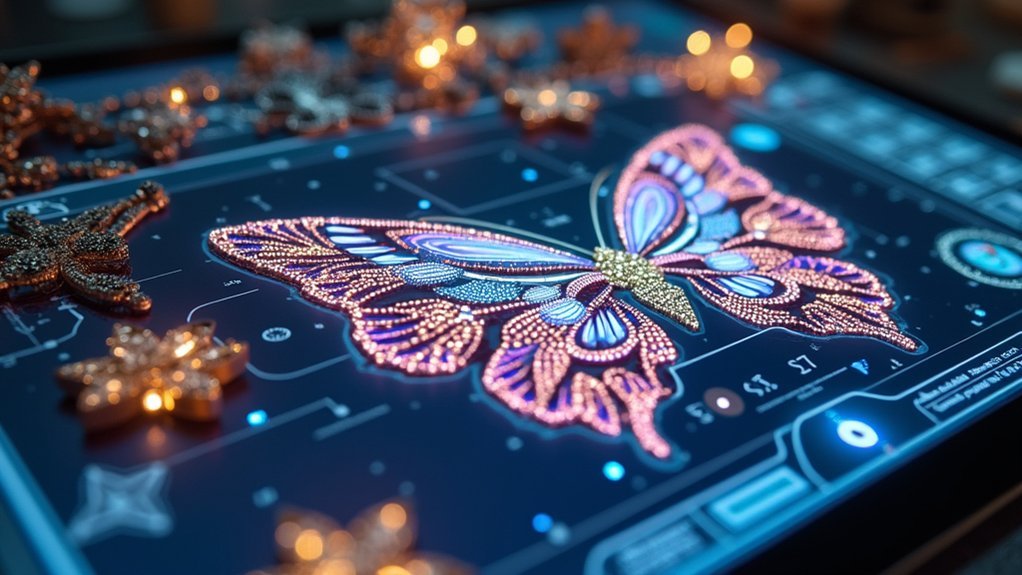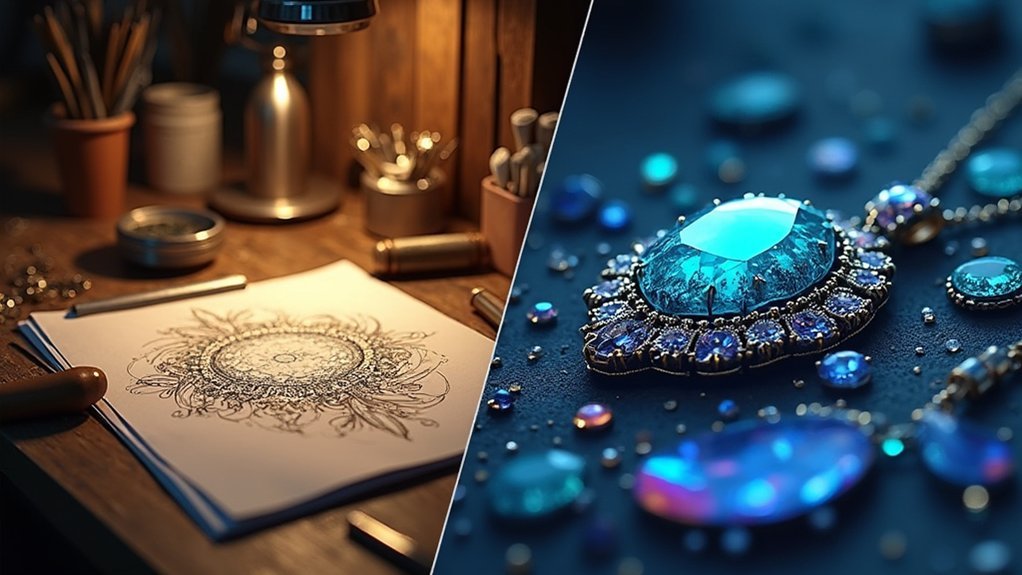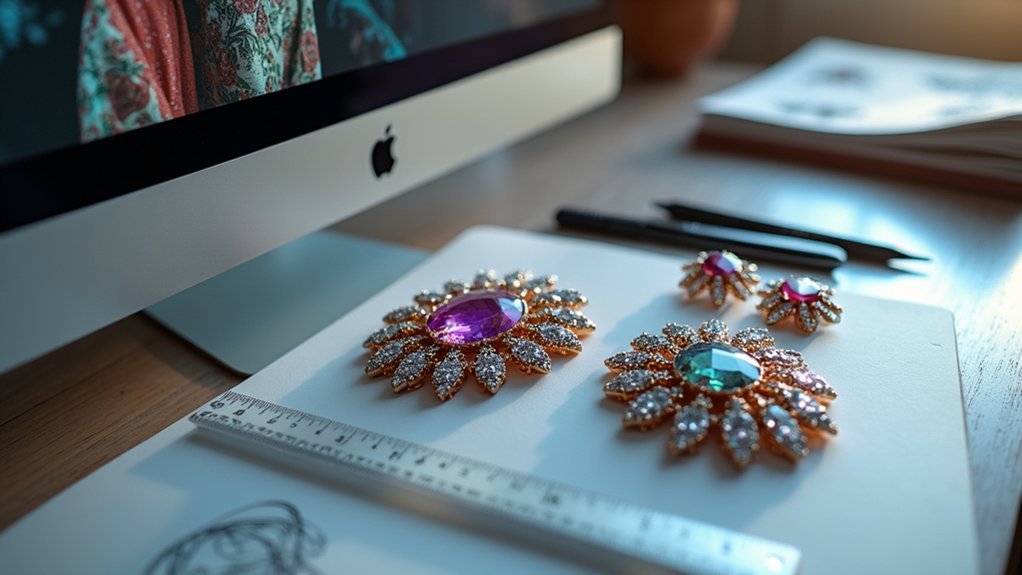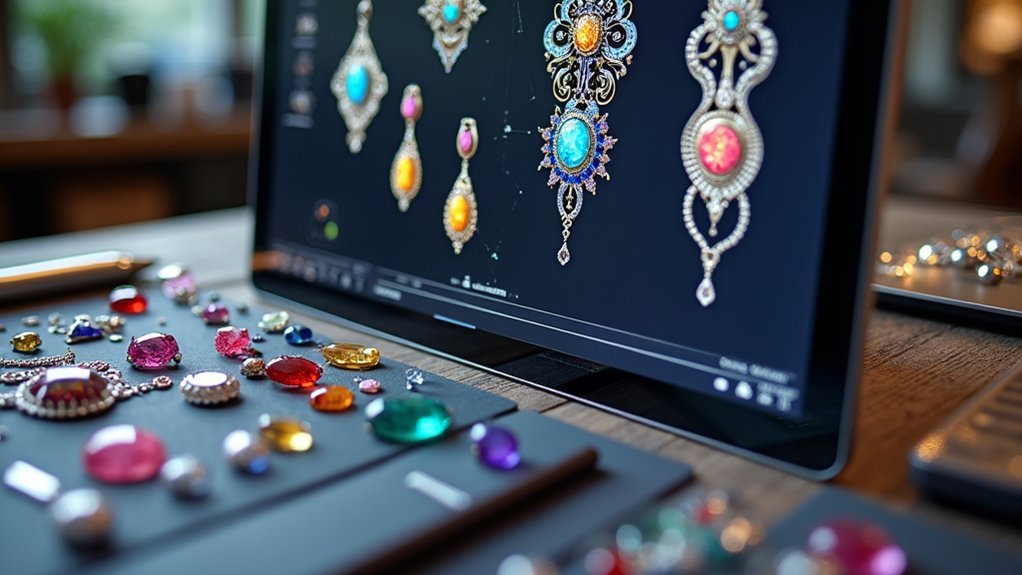CAD design for costume jewelry is computer-aided design technology that lets you create detailed 3D digital models of accessories before physical production. You’ll replace traditional hand-sketching with sophisticated software that offers precise measurements, photorealistic rendering, and unlimited design modifications. This technology allows you to visualize complex embellishments, adjust sizes effortlessly, and export files directly to 3D printers for rapid prototyping. CAD streamlines your workflow from concept to finished piece while reducing material waste and production errors. Understanding the complete design process reveals even greater creative possibilities.
Understanding CAD Technology in Costume Jewelry Design

When you’re designing costume jewelry, CAD technology transforms your creative process by enabling you to craft intricate 3D models with unprecedented precision.
CAD technology revolutionizes costume jewelry design by enabling creators to build intricate 3D models with unparalleled precision and detail.
Computer-Aided Design (CAD) software replaces traditional sketching methods with digital tools that let you visualize every detail before production begins.
You’ll find that CAD jewelry design offers unmatched flexibility for creating intricate designs that would be challenging to achieve through conventional methods.
The software allows you to manipulate elements like size, shape, and materials effortlessly, ensuring your vision translates accurately into the final product.
Most importantly, you can generate STL files directly from your CAD models, streamlining the conversion from digital concept to physical prototype through 3D printing or milling processes.
Benefits of Using CAD Software for Costume Jewelry Creation
Since CAD software revolutionizes how you approach costume jewelry creation, you’ll discover multiple advantages that transform your entire design workflow.
Computer-Aided Design (CAD) enables you to craft intricate 3D models with complex shapes and detailed embellishments that hand-drawing simply can’t match.
You’ll visualize your jewelry designs through photorealistic rendering before production begins, eliminating costly mistakes. The scalability features let you adjust accessories to specific dimensions, perfect for custom costume requirements.
When you’re ready to prototype, direct export capabilities to 3D printers and laser cutters dramatically reduce lead times.
CAD also enhances team collaboration—you can share and modify designs in real-time with colleagues, creating a more efficient workflow that keeps projects moving forward smoothly.
Traditional Jewelry Making Methods Versus Modern CAD Approaches

While traditional jewelry making demands years of mastering hand-carving, casting, and molding techniques, CAD technology puts sophisticated design capabilities directly at your fingertips. You’ll find that traditional methods are time-consuming and difficult to scale, whereas CAD programs enable rapid iterations without physical prototypes.
| Traditional Methods | Modern CAD Approaches |
|---|---|
| Hand-carving requires extensive skill | Digital manipulation accessible to all levels |
| Physical prototypes needed for changes | Virtual modifications in real-time |
| Limited customization options | Unlimited personalization possibilities |
The design process transforms dramatically when jewelry designers embrace CAD technology. You’ll achieve perfect symmetry and precision that’s nearly impossible with hand-crafting. CAD eliminates common errors while shortening production times considerably, letting you focus on creativity rather than technical limitations.
Essential CAD Design Process Steps for Costume Jewelry
You’ll transform your jewelry concepts into precise digital creations through two fundamental stages of the CAD design process.
First, you’ll tackle design conceptualization and planning, where you’ll convert rough sketches into thorough technical specifications.
Then you’ll move into digital modeling and prototyping, creating detailed 3D models that capture every dimension and curve of your costume jewelry piece.
Design Conceptualization and Planning
Before diving into the technical aspects of CAD software, you must establish a solid foundation through careful design conceptualization and planning. This essential phase begins with idea generation, where you’ll create rough sketches and engage in detailed client interactions to conceptualize unique designs.
A skilled CAD Designer transforms these initial concepts into thorough four-view specification sheets, visualizing your jewelry from multiple angles to guarantee every aspect is thoroughly considered.
During this planning stage, you’ll meticulously evaluate material selection, color variations, and sizing requirements to meet specific client specifications.
Computer Aided Design technology enables you to create detailed 3D images that you’ll share with clients for feedback and verification. This collaborative approach allows for necessary adjustments before production, confirming your final designs align perfectly with the client’s vision and expectations.
Digital Modeling and Prototyping
Digital transformation occurs when your approved sketches and specification sheets enter sophisticated 3D modeling software, where you’ll manipulate precise shapes, sizes, and intricate features with mathematical accuracy.
Computer-Aided Design (CAD) becomes your digital workshop, enabling complex engravings and unique motifs that traditional methods can’t achieve. You’ll create photorealistic 3D images for client verification, ensuring expectations align perfectly before production.
Once you’ve secured final approval, your CAD file shifts to the prototyping phase.
CAD and 3D Printing work seamlessly together as essential tools to create physical models. You’ll export designs directly to 3D printers or milling machines, producing tangible prototypes that reveal fit issues and design accuracy.
This digital-to-physical workflow eliminates costly mistakes and validates your costume jewelry design before mass production begins.
Key Features and Tools in Costume Jewelry CAD Software

When you’re selecting CAD software for costume jewelry design, several essential features distinguish professional-grade programs from basic modeling tools. These specialized applications provide extensive capabilities that transform your creative process and enhance production efficiency.
Modern costume jewelry CAD tools offer three critical functionalities:
- Photorealistic Rendering – You’ll visualize final products with accurate colors, textures, and lighting effects before manufacturing begins.
- Automated Material Management – The software generates cut lists that update automatically as designs change, reducing waste and streamlining production.
- Direct Export Integration – You can send designs directly to 3D printers or laser cutters for rapid prototyping.
Additionally, sketch-to-digital conversion tools like 3DSketch bridge traditional hand-drawing with digital precision. This enables you to create intricate components that surpass conventional crafting limitations while maintaining design accuracy throughout development.
Design Possibilities and Customization Options With CAD
Since CAD technology eliminates the constraints of traditional craftsmanship, you’ll discover unprecedented creative freedom in costume jewelry design.
Computer-Aided Design (CAD) empowers you to create intricate features like spirals, loops, and detailed engravings with remarkable precision that surpasses traditional methods.
The customization options available through CAD are virtually limitless. You can easily modify gemstone placements, adjust band thicknesses, and craft asymmetrical designs inspired by various artistic influences.
Without expensive mold requirements, you’ll create personalized pieces tailored to individual client preferences cost-effectively.
CAD’s design possibilities extend to rapid prototyping, enabling quick adjustments based on client feedback.
You’ll also generate photorealistic renderings that provide clients with clear visual representations before production, ensuring their expectations align perfectly with the final product.
From Digital Design to Physical Product: The Manufacturing Process

Three distinct phases transform your CAD costume jewelry designs into tangible products ready for market. Your modeling software creates detailed 3D visualizations that CAD help convert into STL files for direct manufacturing use. This conversion enables 3D printers and milling machines to produce precise prototypes rapidly.
The manufacturing process follows these essential steps:
- Prototype evaluation – You’ll assess fit, style, and functionality while making necessary design adjustments more efficiently than traditional methods.
- Client approval and finalization – Your designs receive approval before moving to production casting in resins or metals.
- Finishing and assembly – Each piece of jewelry undergoes polishing and final assembly to meet quality standards.
This streamlined workflow reduces waste, minimizes production time, and allows intricate customization while maintaining consistent high-quality results throughout your jewelry manufacturing process.
Choosing the Right CAD Software for Your Costume Jewelry Projects
You’ll need to evaluate different CAD software options based on their specific features and how well they align with your costume jewelry design requirements.
Your budget will play an essential role in determining which software you can access, from free options to premium subscriptions with advanced capabilities.
Consider both the upfront costs and ongoing accessibility when making your decision, as this choice will greatly impact your design workflow and project outcomes.
Software Features Comparison
When evaluating CAD software options for costume jewelry design, you’ll want to prioritize features that directly impact your creative workflow and production efficiency.
Computer-Aided Design (CAD) platforms vary greatly in their capabilities, so understanding which tools used will best serve your projects is essential for creating professional designs without compromising quality or timeline.
Key features to compare include:
- Rendering Quality – Photorealistic visualization capabilities that let you preview finished pieces before production.
- Export Compatibility – Direct integration with 3D printers and laser cutters for seamless manufacturing workflows.
- Collaboration Tools – Shared workspaces, mood boards, and automatic cut lists that update dynamically as your designs evolve.
These features determine whether you’ll efficiently transform concepts into tangible costume jewelry pieces.
Budget and Accessibility
Beyond evaluating software capabilities, your budget constraints and accessibility needs will ultimately determine which CAD platform fits your costume jewelry design workflow.
Budget-friendly options like SOLIDWORKS for Makers offer subscriptions at $48 annually or $15 monthly, making professional-grade tools accessible to hobbyists. You’ll find many programs provide free trials or educational versions, letting you test features before purchasing.
Prioritize software with a user-friendly interface and 3D printing support to minimize learning curves and boost productivity.
Cloud-based solutions like SOLIDWORKS xDesign eliminate installation costs while enabling multi-device access.
Don’t overlook community support when making your decision—strong support networks accelerate skill development and provide valuable design insights for your costume jewelry projects.
Frequently Asked Questions
What Is CAD Design in Jewellery?
You’ll use CAD design in jewelry to create precise 2D and 3D digital models using specialized software. It lets you craft intricate designs, generate STL files for 3D printing, and visualize pieces before manufacturing.
How Much Does a Jewelry CAD Design Cost?
You’ll pay $50-$300 per hour or $100-$1,500 flat fees for jewelry CAD design, depending on complexity and designer experience. Some charge 10-25% of your piece’s final value instead.
What CAD Program Do Jewelry Designers Use?
You’ll find jewelry designers commonly use Rhino, SOLIDWORKS, and MatrixGold as their primary CAD programs. These specialized software options offer precision tools, 3D modeling capabilities, and direct export features for manufacturing jewelry pieces efficiently.
What Are the Requirements for Jewellery CAD?
You’ll need specialized 2D/3D modeling software, understanding of STL file creation, precise measurement skills, materials knowledge for structural integrity, and familiarity with casting and finishing processes to create marketable jewelry designs.
In Summary
You’ll find CAD design transforms your costume jewelry creation process, offering precision, efficiency, and unlimited creative possibilities. You can experiment with complex designs, visualize concepts before production, and streamline manufacturing workflows. Whether you’re starting out or scaling up, CAD software empowers you to bring your artistic vision to life while reducing costs and minimizing errors. You’re now equipped to embrace this technology and revolutionize your jewelry design approach.





Leave a Reply